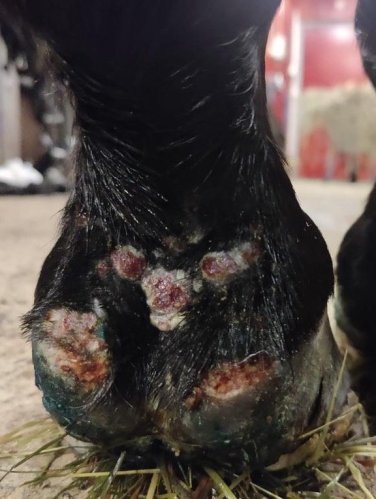Racehorses plagued by poxvirus – how to prevent future outbreaks?
A few years ago, around hundreds of Finnish horses contracted a rapidly spreading skin infection, pastern dermatitis. It was revealed that the outbreak was caused by a novel poxvirus that is suspected to have brought about symptoms also in the people looking after the horses. Studying the virus helps us to recognise future outbreaks in time and minimise their impacts.Published 6.6.2024
Text: Jenni Virtanen
Image: Shutterstock
Editing: Viestintätoimisto Jokiranta Oy
Poxviruses cause skin and systemic infections both in animals and humans. They are often zoonoses, which means that they can be transmitted between animals and humans. The best known poxviruses are smallpox, which caused millions of deaths as late as the early 1970s, and monkeypox, which caused more than 90,000 humans to fall ill a couple of years ago.
One of the most significant poxvirus genera are the parapoxviruses that cause skin and mucous membrane lesions in several animal species. Many of them are notifiable animal diseases, whose prevalence is being monitored.
Poxviruses are associated with a major threat of outbreak. This threat was materialised in Finland in winter 2021–2022 when it was estimated that hundreds of racehorses fell ill with a violent and rapidly spreading skin infection. Our research aimed at finding out the cause of the outbreak, developing the means to control it and preparing for future outbreaks.
Rapid identification of a pathogen is vital
At the turn of 2021–2022, veterinarians started contacting us with regard to a contagious infective disease in racehorses. The symptoms, which lasted 2–3 weeks on average, included painful skin lesions in the pastern area of the lower parts of the legs as well as general swelling in the legs and limping. Furthermore, long-lasting skin and hoof lesions were reported. The disease spread across the whole country in a couple of months. Approximately one third of the horses fell ill in the stables that were affected by the disease. Training of the sick horses was usually discontinued, which led to financial losses.
The probable pathogen causing the disease was identified to be equine parapoxvirus that had previously (in 2013) been described in literature as affecting only one horse – also in Finland. No previous outbreaks had been observed. Rapid identification of the pathogen is vital, as it allows us to take measures before the disease spreads wider. In this case, the novelty of the pathogen hindered its early prevention and, for instance, no proper diagnostics were available for the virus.
With the help of project funding, we have been able to develop methods for efficient detection of the virus as a means of controlling future outbreaks. Furthermore, the results have been communicated to trainers, study participants and veterinarians, who treat horses.

The symptoms of infective disease in racehorses included painful skin lesions in the pastern area of the lower parts of the legs. Image: https://doi.org/10.1099/jgv.0.001940.
Knowing the spreading mechanism provides help for prevention
Knowing the spreading routes is an important part of the prevention of infectious diseases as it enables targeted prevention. For example, identification of the host and vector animal species of epidemic nephropathy and tick-borne encephalitis has enabled risk monitoring, protection from risk animal species and, thus, control over the number of cases.
It is mostly unclear how the disease caused by parapoxvirus spread from one horse to another. On the basis of a survey, the most significant risk factor for horses falling ill was having racehorses – riding stables were spared from this outbreak. More than half of the stable representatives estimated that the infection had been caught during a visit to a race event.
In addition to direct contact, many viruses can spread via, for example, surfaces, equipment and other animals, but the exact spreading mechanisms of this virus are not known. Therefore, we are collecting samples from stable environments and hope to discover where the virus is found. Since many known poxviruses are spread by rodents, we are also investigating small animals found in the stable environment. If the virus is found in small animals or the stable environment, spreading of the disease can be prevented by pest control and disinfection measures.
Skin symptoms occurred also in humans
Of the five previously known parapoxviruses, three are also known to cause disease in humans. A virus that is very similar to the equine parapoxvirus has previously been observed in the United States in humans who have had contact with horses and donkeys.
In our research, symptoms were also found in humans who had been looking after of the horses. Although we collected no samples from humans, this all suggests that the equine parapoxvirus is capable of causing a similar skin infection in humans as well. Therefore, it is important to ensure good hand hygiene and wear protective gloves when looking after horses with symptoms. In order to confirm the zoonotic nature of the disease, it is also important to collect samples from humans with skin symptoms who have had contact with sick horses.
Research helps to prepare for future outbreaks
According to what has been heard from people involved in horse racing, a disease with a similar clinical picture has occurred also previously on a smaller scale at intervals of two to three years but no samples have been examined then. Thus, it is very likely that new outbreaks will occur. This is why we are examining archived blood samples from previous years to find out the extent to which the disease has previously occurred undetected. This will help us to predict the risk and time of the next outbreak.
This research is a part of a larger research entity our group is involved in, the aim of which is to examine viruses in humans and animals as well as to predict and prevent future outbreaks. The pastern dermatitis outbreak caused by the equine parapoxvirus is an example of a rapid and easily spreading infectious disease that caused suffering to the animals as well as health risks and financial losses to humans. Although the outbreak spread widely in the years 2021–2022, examining it now will help us to identify future outbreaks in time and minimise their impacts.

PhD Jenni Virtanen defended her doctoral thesis at the University of Helsinki in 2022. In her thesis, Virtanen studied the spreading and prevention of a significant animal pathogen and, additionally, she has participated in studies on corona viruses, influenza viruses and other respiratory viruses. Virtanen works at the University of Helsinki as a member of a research group studying infectious diseases. She concentrates on the diversity and spreading of poxviruses and aims at advancing preparedness for outbreaks.
Links:
